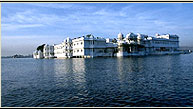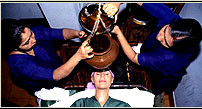-| Sarnath | -
Location:

Sarnath, 5 kms. to the north of Varanasi in Uttar Pradesh, is the holy city
where Lort Buddha delivered His first sermon or turn the wheel of the law after
his enlightenment at Bodhgaya. Thus, Sarnath became one of the four holiest
places to the Buddhist world. The centre was known as Sad – Dharma –
Chakra – Maha – Vihara in late historical time and is one of the richest
in Buddhist antiquities from the time to Mauryan Emperor Ashoka (3rd century
BC) till 12th century AD. Ashoka built here one of his Dharmarajika stupas and
near it erected a pillar surrounded by a magnificent capital of four lions and
inscribed on it an edict threatening dissenting monks and nus with ex–communication
from Sangha.
Sarnath was the place more then 2500 years ago, where the great Buddhist tradition
of the Sangha was set in motion for popularising the teaching of the Great Ascetic
worldwide. Lord Buddha with His five disciples formed the first Sangha along
with Yasa of Varanasi and his 55 friends. The beginning of the celebrated Mantra
“Buddham Sharnam Gachchami” owes it origin in Sarnath. Three jewels
of Buddhidm are as following -
I go for refuge to the Buddha,
I go for refuge to the wheel of law,
I go for the refuge to the Sangha.
These three jewels, that were first laid down here, have remained unchanged
ever since. Hence, rightly every Buddhist pilgrims after BodhGaya endeavours
to be blessed with a visit to Sarnath in his life time.
Dhamekh stupa bears particular significance at Sarnath as it signifies the seat
of the Lord Buddha as he proclaimed his faith. It is about 34 meters in height.
Including the foundation, it can measured up to 42 meters. Besides this, there
are Dharmarajika Stupa and original Mulgandha Kuti temple which, according to
Hiuen Tsang, was about 61 meter high. Buddha is said to have rested and meditated
here when he used to be in Sarnath. A smooth shinning chunar sand stone pillar,
called the Ashoka Pillar commemorates his visit and lays the foundation of the
Buddhist Sangha here. The lion capital on the top of this pillar is now the
National Emblem of Government of India. The original structure is now displayed
at the Archaeological Museum near the site.




